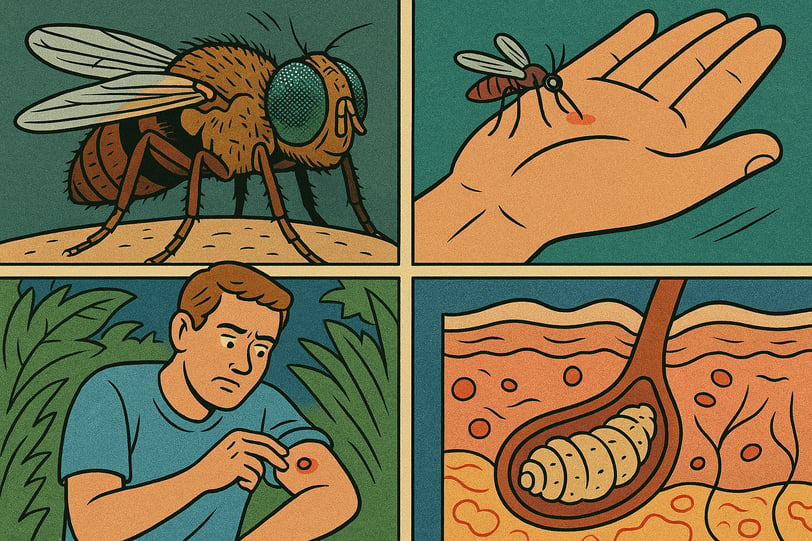The Fly That Lays Eggs in Human Skin: The Botfly Explained
The human botfly is a real parasite that lays its eggs under human skin. Discover how it works, where it lives, and why it’s so disturbingly effective..
WEIRD ANIMALS
Driver
5/25/20253 min read


🦟 The Fly That Lays Eggs Inside Living Flesh — And It Might Be Closer Than You Think
It starts with an itch.
Then, maybe a sting.
And soon… something is wriggling under your skin.
No, this isn’t a horror story. It’s the real-life nightmare caused by Dermatobia hominis, also known as the human botfly — an insect so disturbingly adapted to parasitism that it’s practically nature’s version of body horror.
And the worst part? It doesn’t just exist in distant jungles.
It could be waiting for you… after a tropical vacation.
Let’s dive into the grotesque but fascinating world of a fly that turns living humans into incubators — and somehow gets away with it.
🦟 The Botfly: A Parasite That Outsources Its Job
The human botfly doesn’t lay its eggs directly on you.
That would be too easy.
Instead, it uses an unwitting courier — usually a mosquito or other biting insect — as its egg-delivery drone.
Here’s how it works:
The botfly grabs a mosquito mid-air and glues its eggs onto the mosquito’s body.
When that mosquito lands on a human, the warmth of the skin causes the botfly eggs to hatch instantly.
The newborn larvae drop onto your skin and burrow into the hole made by the mosquito bite — or simply dissolve their way in using enzymes.
You never see it coming. And once they’re in, they stay — for weeks.
🧬 Living Inside You: A Masterclass in Parasitism
Once inside, the larva creates a small breathing hole in your skin — like a snorkel — and settles in to feed on your tissue.
Over the next 4 to 8 weeks, it grows inside your body:
You may feel a pulsing sensation.
You might notice fluid leaking from a small wound.
And in some cases, you can actually see the larva’s body wriggling beneath the skin.
People often mistake it for a spider bite, a boil, or an ingrown hair… until it moves.
It’s not painful at first, but becomes increasingly uncomfortable. The pressure, the inflammation, and the psychological horror of knowing you’re hosting a live animal under your skin are enough to drive some people into panic.
🌎 Where Can You Catch One?
The botfly is native to Central and South America, particularly in:
Brazil
Belize
Costa Rica
Honduras
Peru
But here’s the twist: most infections happen not to locals, but to tourists. People on vacation, hiking, or exploring rainforests unknowingly return home with a tiny squatter in their skin.
By the time symptoms appear, they’re often thousands of miles from the site of infection — and doctors unfamiliar with the condition may misdiagnose it.
Yes, that means you could go to the ER with what you think is a pimple, and discover… it has a face.
🏥 How Do You Remove a Botfly?
There are several methods, none of them pleasant:
Asphyxiation:
Covering the breathing hole with petroleum jelly or bacon to suffocate the larva, forcing it to surface.Extraction:
Using tweezers to pull the larva out whole — but if it tears, it can cause severe infection.Surgery:
In stubborn cases, minor surgery may be needed to fully remove it and clean the wound.
And yes — some people keep the larva in a jar afterward, like a twisted souvenir.
🧠 Why Doesn't the Body Fight It Off?
Strangely, the botfly larva releases chemicals that dull the immune response. It tricks your body into treating it like normal tissue, minimizing pain and inflammation in the early stages.
This means it can live comfortably under your skin, rent-free, for weeks — without your immune system even knowing it’s there.
A parasite with stealth mode.
🧪 Botfly Larvae Have Medical Potential?
Here’s where it gets weirder: some researchers are studying botfly enzymes for use in skin grafts and wound healing, because of the way they interact with tissue without causing rejection.
It’s possible that this grotesque parasite may one day help heal human injuries — the same way leeches are used in microsurgery and maggots in wound cleaning.
Horrifying? Yes.
Biologically elegant? Also yes.
🧯 Can You Prevent Infection?
Yes — and if you’re traveling to botfly territory, you should:
Use insect repellent with DEET
Wear long sleeves and pants in jungle areas
Sleep under mosquito nets
Wash and check bites regularly, especially after rural exposure
And most importantly: if you find a bite that won’t heal, gets larger, leaks fluid, or seems to move — don’t wait.
You might have a visitor.
🧟 Final Thought: Nature Doesn’t Need Sci-Fi
The botfly is proof that nature doesn’t need to invent monsters — they’re already here.
A creature that hijacks another insect to implant larvae inside human skin, grows under the surface, breathes through your flesh, and escapes like a horror movie villain?
That’s not fiction.
That’s biology.
And it might be the weirdest, most skin-crawling thing you’ll ever learn is 100% true.
📚 Sources / References:
Centers for Disease Control (CDC) – Dermatobia hominis fact sheet
Journal of Travel Medicine – Human botfly infestation in returning travelers
Entomology Today – Parasitic Flies and Their Surprising Medical Applications
National Geographic – Botflies: Parasites in the Jungle
Clinical Microbiology Reviews – Myiasis: Infestation with Fly Larvae
